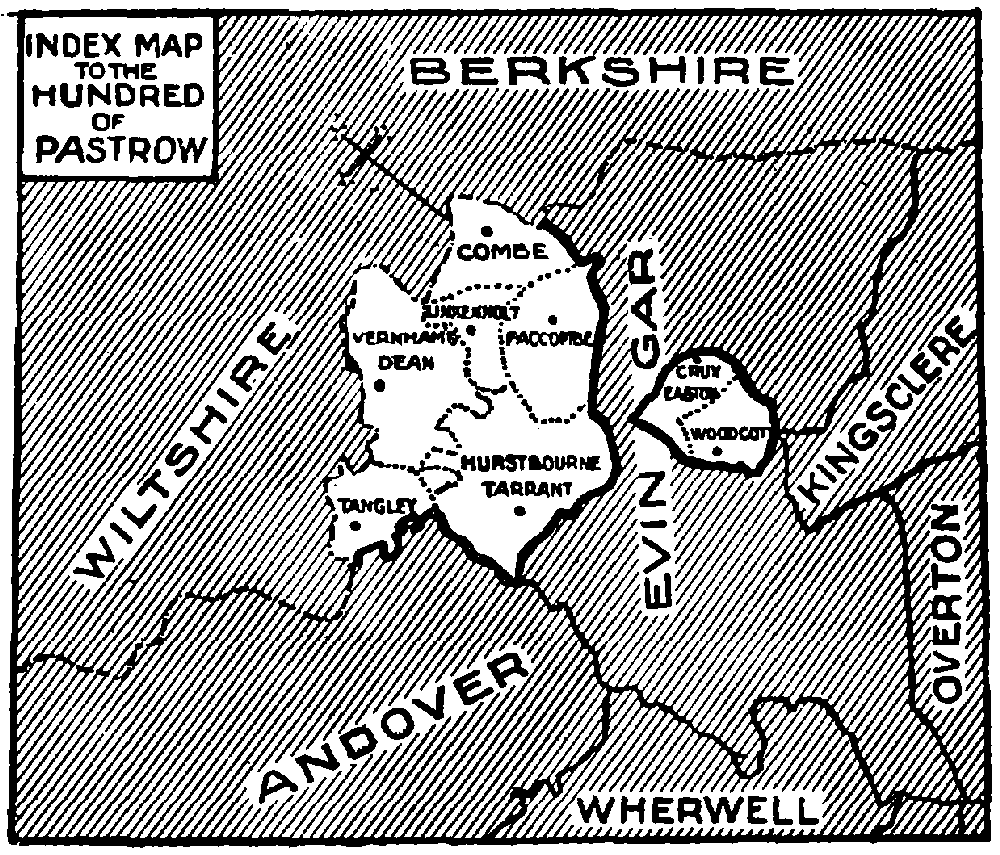A History of the County of Hampshire: Volume 4. Originally published by Victoria County History, London, 1911.
This free content was digitised by double rekeying. All rights reserved.
'The hundred of Pastrow', in A History of the County of Hampshire: Volume 4, ed. William Page (London, 1911), British History Online https://prod.british-history.ac.uk/vch/hants/vol4/pp308-309 [accessed 7 February 2025].
'The hundred of Pastrow', in A History of the County of Hampshire: Volume 4. Edited by William Page (London, 1911), British History Online, accessed February 7, 2025, https://prod.british-history.ac.uk/vch/hants/vol4/pp308-309.
"The hundred of Pastrow". A History of the County of Hampshire: Volume 4. Ed. William Page (London, 1911), British History Online. Web. 7 February 2025. https://prod.british-history.ac.uk/vch/hants/vol4/pp308-309.
THE HUNDRED OF PASTROW
Containing The Parishes Of Combe; Crux Easton; Faccombe; Hurstbourne Tarrant; Linkenholt; Tangley; Vernhams Dean; Woodcott
The above list represents the extent of the hundred at the time of the Population Returns of 1831. Tangley was removed to Andover Hundred before 1841, probably in exchange for the parishes of Thruxton and Upper Clatford, (fn. 1) which now form part of Pastrow, and in 1895 Combe was transferred to Berkshire under the provisions of the Local Government Act 1894 (56 and 57 Vict. cap. 73).
At the time of the Domesday Survey the hundred of Pastrow was called the hundred of Esseborne (i.e. Hurstbourne), and comprised the parishes of Combe, (fn. 2) Crux Easton, (fn. 3) Linkenholt (fn. 4) and Litchfield, (fn. 5) and the tithing of Upton, (fn. 6) which is situated partly in the parish of Hurstbourne Tarrant and partly in that of Vernhams Dean. Faccombe, which at this time included Tangley, was in the hundred of Titchfield (fn. 7); Hurstbourne Tarrant, which comprised Vernhams Dean, was entered, doubtless owing to imperfect rubrication, under Basingstoke Hundred (fn. 8); while the name of the hundred of which Woodcott then formed part is not given. (fn. 9) The land included in the hundred was assessed in the reign of Edward the Confessor at 18 hides, and at the time of the Survey at about 9 hides. At the beginning of the 13th century the name of the hundred was still unchanged, as is seen from the Testa de Nevill, where the manors of Hurstbourne Tarrant, Vernhams Dean and Faccombe are entered ' In hundredo de Husseburn,' (fn. 10) but soon afterwards its name was changed to Pachestrow or Pastrow, as is clear from an Assize Roll of 1236. (fn. 11) By the 14th century the hundred seems to have assumed its modern dimensions, the only exception being that it still comprised part of the parish of Litchfield. (fn. 12) In 1316, however, by some error, in a return of the various hundreds in Hampshire, the hundred of Kingsclere which existed at the time of the Domesday Survey was omitted altogether, and consequently Kingsclere, Sydmonton, North Oakley, Earlstone and Wolverton were entered under Pastrow Hundred. (fn. 13) That this was a mistake seems clear from subsequent Subsidy Rolls. (fn. 14) This hundred has always belonged to the Crown. (fn. 15)

Index Map to the Hundred of Pastrow
